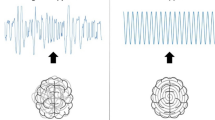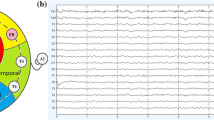Abstract
We analysed the electroencephalogram (EEG) from Alzheimer’s disease (AD) patients with two nonlinear methods: approximate entropy (ApEn) and auto mutual information (AMI). ApEn quantifies regularity in data, while AMI detects linear and nonlinear dependencies in time series. EEGs from 11 AD patients and 11 age-matched controls were analysed. ApEn was significantly lower in AD patients at electrodes O1, O2, P3 and P4 (p < 0.01). The EEG AMI decreased more slowly with time delays in patients than in controls, with significant differences at electrodes T5, T6, O1, O2, P3 and P4 (p < 0.01). The strong correlation between results from both methods shows that the AMI rate of decrease can be used to estimate the regularity in time series. Our work suggests that nonlinear EEG analysis may contribute to increase the insight into brain dysfunction in AD, especially when different time scales are inspected, as is the case with AMI.


Similar content being viewed by others
Abbreviations
- AD:
-
Alzheimer’s disease
- AMI:
-
Auto mutual information
- ApEn:
-
Approximate entropy
- AUC:
-
Area under the ROC curve
- CMI:
-
Cross mutual information
- D 2 :
-
Correlation dimension
- EEG:
-
Electroencephalogram
- L1:
-
Largest Lyapunov exponent
- LZ:
-
Lempel-Ziv
- MI:
-
Mutual information
- MMSE:
-
Mini-mental state examination
- MSE:
-
Multiscale entropy
- ROC:
-
Receiver operating characteristic
- SampEn:
-
Sample entropy
- SD:
-
Standard deviation
References
Abásolo D, Hornero R, Espino P et al (2005) Analysis of regularity in the EEG background activity of Alzheimer’s disease patients with approximate entropy. Clin Neurophysiol 116:1826–1834. doi:10.1016/j.clinph.2005.04.001
Abásolo D, Hornero R, Espino P et al (2006) Entropy analysis of the EEG background activity in Alzheimer’s disease patients. Physiol Meas 27:241–253. doi:10.1088/0967-3334/27/3/003
Abásolo D, Hornero R, Gómez C et al (2006) Analysis of EEG background activity in Alzheimer’s disease patients with Lempel-Ziv complexity and central tendency measure. Med Eng Phys 28:315–322. doi:10.1016/j.medengphy.2005.07.004
Alonso JF, Mañanas MA, Hoyer D et al (2007) Evaluation of respiratory muscles activity by means of mutual information function at different levels of ventilatory effort. IEEE Trans Biomed Eng 54:1573–1582. doi:10.1109/TBME.2007.893494
Andrzejak RG, Lehnertz K, Moormann F et al (2001) Indications of nonlinear deterministic and finite-dimensional structures in time series of brain electrical activity: dependence on recording region and brain state. Phys Rev E Stat Nonlin Soft Matter Phys 64:061907. doi:10.1103/PhysRevE.64.061907
Babloyantz A, Destexhe A (1988) The Creutzfeldt-Jakob disease in the hierarchy of chaotic attractors. In: Markus M, Müller S, Nicolis G (eds) From chemical to biological organization. Springer, Berlin, pp 307–316
Bird TD (2001) Alzheimer’s disease and other primary dementias in Harrison’s principles of internal medicine. In: Braunwald E, Fauci AS, Kasper DL et al (eds) The McGraw-Hill Companies Inc., New York, pp 2391–2399
Bruhn J, Röpcke H, Rehberg B et al (2000) Electroencephalogram approximate entropy correctly classifies the occurrence of burst suppression pattern as increasing anesthetic drug effect. Anesthesiology 93:981–985. doi:10.1097/00000542-200010000-00018
Costa M, Goldberger AL, Peng CK (2005) Multiscale entropy analysis of biological signals. Phys Rev E Stat Nonlin Soft Matter Phys 71:021906. doi:10.1103/PhysRevE.71.021906
David O, Cosmelli D, Friston KJ (2004) Evaluation of different measures of functional connectivity using a neural mass model. Neuroimage 21:659–673. doi:10.1016/j.neuroimage.2003.10.006
De Lucia M, Fritschy J, Dayan P et al (2008) A novel method for automated classification of epileptiform activity in the human electroencephalogram-based on independent component analysis. Med Biol Eng Comput 46:263–272. doi:10.1007/s11517-007-0289-4
Eckmann JP, Ruelle D (1992) Fundamental limitations for estimating dimensions and Lyapunov exponents in dynamical systems. Physica D 56:185–187. doi:10.1016/0167-2789(92)90023-G
Escudero J, Abásolo D, Hornero R et al (2006) Analysis of electroencephalograms in Alzheimer’s disease patients with multiscale entropy. Physiol Meas 27:1091–1106. doi:10.1088/0967-3334/27/11/004
Folstein MF, Folstein SE, McHugh PR (1975) Mini-mental state. A practical method for grading the cognitive state of patients for the clinician. J Psychiatr Res 12:189–198. doi:10.1016/0022-3956(75)90026-6
Fraser AM, Swinney HL (1986) Independent coordinates for strange attractors from mutual information. Phys Rev A 33:1134–1140. doi:10.1103/PhysRevA.33.1134
Goldberger AL, Peng CK, Lipsitz LA (2002) What is physiologic complexity and how does it change with aging and disease? Neurobiol Aging 23:23–26. doi:10.1016/S0197-4580(01)00266-4
Gómez C, Hornero R, Abásolo D et al (2007) Analysis of the magnetoencephalogram background activity in Alzheimer’s disease patients with auto mutual information. Comput Methods Program Biomed 87:239–247. doi:10.1016/j.cmpb.2007.07.001
Hesse CW, James CJ (2007) Tracking and detection of epileptiform activity in multichannel ictal EEG using signal subspace correlation of seizure source scalp topographies. Med Biol Eng Comput 45:909–916. doi:10.1007/s11517-006-0103-8
Hornero R, Aboy M, Abásolo D et al (2005) Interpretation of approximate entropy: analysis of intracranial pressure approximate entropy during acute intracranial hypertension. IEEE Trans Biomed Eng 52:1671–1680. doi:10.1109/TBME.2005.855722
Hoyer D, Pompe B, Chon KH et al (2005) Mutual information function assesses autonomic information flow of heart rate dynamics at different time scales. IEEE Trans Biomed Eng 52:584–592. doi:10.1109/TBME.2005.844023
Hoyer D, Friedrich H, Frank B et al (2006) Autonomic information flow improves prognostic impact of task force HRV monitoring. Comput Methods Program Biomed 81:246–255. doi:10.1016/j.cmpb.2006.01.002
Huang L, Yu P, Ju F et al (2003) Prediction of response to incision using the mutual information of electroencephalogram during anaesthesia. Med Eng Phys 25:321–327. doi:10.1016/S1350-4533(02)00249-7
Jeong J (2004) EEG dynamics in patients with Alzheimer’s disease. Clin Neurophysiol 115:1490–1505. doi:10.1016/j.clinph.2004.01.001
Jeong J, Chae JH, Kim SY et al (2001) Nonlinear dynamic analysis of the EEG in patients with Alzheimer’s disease and vascular dementia. J Clin Neurophysiol 18:58–67. doi:10.1097/00004691-200101000-00010
Jeong J, Gore JC, Peterson BS (2001) Mutual information analysis of the EEG in patients with Alzheimer’s disease. Clin Neurophysiol 112:827–835. doi:10.1016/S1388-2457(01)00513-2
Kantz H, Schreiber T (1997) Nonlinear time series analysis. Cambridge University Press, Cambridge
Lehnertz K, Mormann F, Kreuz T et al (2003) Seizure prediction by nonlinear EEG analysis. IEEE Eng Med Biol 22:57–63. doi:10.1109/MEMB.2003.1191451
Markand ON (1990) Organic brain syndromes and dementias. In: Daly DD, Pedley TA (eds) Current practice of clinical electroencephalography. Raven Press, New York, pp 401–423
Mendez MO, Bianchi AM, Montano N et al (2008) On arousal from sleep: time–frequency análisis. Med Biol Eng Comput 46:341–351. doi:10.1007/s11517-008-0309-z
Na SH, Jin SH, Kim SY et al (2002) EEG in schizophrenic patients: mutual information analysis. Clin Neurophysiol 113:1954–1960. doi:10.1016/S1388-2457(02)00197-9
Palacios M, Friedrich H, Götze C et al (2007) Changes of autonomic information flow due to idiopathic dilated cardiomyopathy. Physiol Meas 28:677–688. doi:10.1088/0967-3334/28/6/006
Palus M (1996) Coarse-grained entropy rates for characterization of complex time series. Physica D 93:64–77. doi:10.1016/0167-2789(95)00301-0
Pincus SM (1991) Approximate entropy as a measure of system complexity. Proc Natl Acad Sci USA 88:2297–2301. doi:10.1073/pnas.88.6.2297
Pincus SM (2001) Assessing serial irregularity and its implications for health. Ann N Y Acad Sci 954:245–267
Pincus SM, Goldberger AL (1994) Physiological time series analysis: what does regularity quantify? Am J Physiol Heart Circ Physiol 266:H1643–H1656
Pincus SM, Keefe DL (1992) Quantification of hormone pulsatility via an approximate entropy algorithm. Am J Physiol Endocrinol Metab 262:E741–E754
Pompe B (1993) Measuring statistical dependencies in a time series. J Stat Phys 73:587–610. doi:10.1007/BF01054341
Pompe B, Blidh P, Hoyer D et al (1998) Using mutual information to measure coupling in the cardiorespiratory system. IEEE Eng Med Biol 17:32–39. doi:10.1109/51.731318
Pritchard WS, Duke DW, Coburn KL et al (1994) EEG-based neural-net predictive classification of Alzheimer’s disease versus control subjects is augmented by non-linear EEG measures. Electroencephalogr Clin Neurophysiol 91:118–130. doi:10.1016/0013-4694(94)90033-7
Radhakrishnan N, Gangadhar BN (1998) Estimating regularity in epileptic seizure time-series data. A complexity-measure approach. IEEE Eng Med Biol 17:89–94. doi:10.1109/51.677174
Röschke J, Fell J, Beckmann P (1995) Non-linear analysis of sleep EEG data in schizophrenia: calculation of the principal Lyapunov exponent. Psychiatry Res 56:257–269. doi:10.1016/0165-1781(95)02562-B
Rossor M (2001) Alzheimer’s disease. In: Donaghy M (ed) Brain’s diseases of the nervous system. Oxford University Press, Oxford, pp 750–754
Selkoe DJ (1994) Cell biology of the amyloid beta-protein precursor and the mechanism of Alzheimer’s disease. Annu Rev Cell Biol 10:373–403. doi:10.1146/annurev.cb.10.110194.002105
Stam CJ, Jelles B, Achtereekte HAM et al (1995) Investigation of EEG non-linearity in dementia and Parkinson’s disease. Electroencephalogr Clin Neurophysiol 95:309–317. doi:10.1016/0013-4694(95)00147-Q
Stam CJ (2005) Nonlinear dynamical analysis of EEG and MEG: review of an emerging field. Clin Neurophysiol 116:2266–2301. doi:10.1016/j.clinph.2005.06.011
Varma NK, Kushwaha R, Beydoun A et al (1997) Mutual information analysis and detection of interictal morphological differences in interictal epileptiform discharges of patients with partial epilepsies. Electroencephalogr Clin Neurophysiol 103:426–433. doi:10.1016/S0013-4694(97)00039-4
Vastano JA, Swinney HL (1988) Information transport in spatiotemporal systems. Phys Rev Lett 60:1773–1776. doi:10.1103/PhysRevLett.60.1773
Xu J, Liu ZR, Liu R et al (1997) Information transformation in human cerebral cortex. Physica D 106:363–374. doi:10.1016/S0167-2789(97)00042-0
Zhang XS, Roy RJ (2001) Derived fuzzy knowledge model for estimating the depth of anesthesia. IEEE Trans Biomed Eng 48:312–323. doi:10.1109/10.914794
Zweig MH, Campbell G (1993) Receiver-operating characteristic (ROC) plots: a fundamental evaluation tool in clinical medicine. Clin Chem 39:561–577
Acknowledgments
This work was supported by grant projects VA102A06 and VA108A06 from Consejería de Educación de la Junta de Castilla y León and by a grant project from Ministerio de Educación y Ciencia and FEDER grant MTM 2005-08519-C02-01.
Author information
Authors and Affiliations
Corresponding author
Rights and permissions
About this article
Cite this article
Abásolo, D., Escudero, J., Hornero, R. et al. Approximate entropy and auto mutual information analysis of the electroencephalogram in Alzheimer’s disease patients. Med Biol Eng Comput 46, 1019–1028 (2008). https://doi.org/10.1007/s11517-008-0392-1
Received:
Accepted:
Published:
Issue Date:
DOI: https://doi.org/10.1007/s11517-008-0392-1




